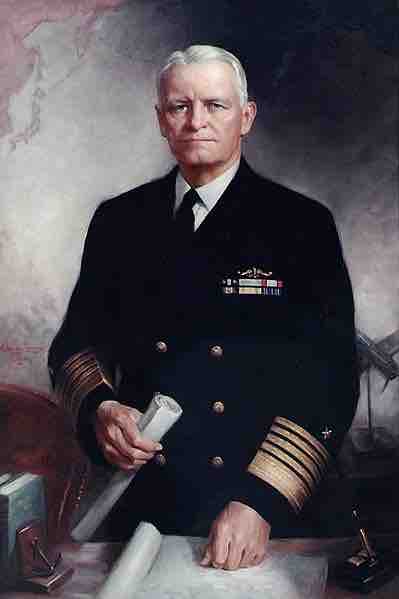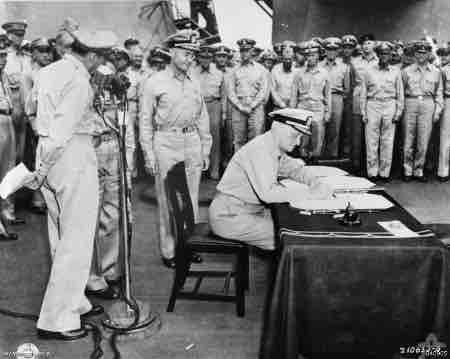BACKGROUND
Ten days after the attack on Pearl Harbor on 7 December 1941, Chester W. Nimitz was selected Commander in Chief of the U.S. Pacific Fleet with the rank of admiral. Assuming command at the most critical period of the war in the Pacific, Nimitz, despite the losses from the attack on Pearl Harbor and the shortage of ships, planes, and supplies, successfully organized his forces to halt the Japanese advance. On March 24, 1942, the newly formed U.S.-British Combined Chiefs of Staff issued a directive designating the Pacific theater an area of American strategic responsibility. Six days later the US Joint Chiefs of Staff (JCS) divided the theater into three areas: the Pacific Ocean Areas (POA), the Southwest Pacific Area (SWPA, commanded by General Douglas MacArthur), and the South East Pacific area. The JCS designated Nimitz as "Commander in Chief, Pacific Ocean Areas," with operational control over all Allied units (air, land, and sea) in that area.

Fleet Admiral Chester W. Nimitz
Nimitz was a five-star admiral of the United States Navy. He held the dual command of Commander in Chief, United States Pacific Fleet (CinCPac), for U.S. naval forces and Commander in Chief, Pacific Ocean Areas (CinCPOA), for United States and Allied air, land, and sea forces during World War II.
NIMITZ' WAR IN THE PACIFIC
As rapidly as ships, men, and material became available, Nimitz shifted to the offensive and defeated the Japanese navy in the Battle of the Coral Sea (May 4-8, 1942), the pivotal Battle of Midway (June 4-7, 1942), and in the Solomon Islands Campaign. Prior to the Battle of the Coral Sea, Nimitz and and his staff discussed deciphered messages and agreed that the Japanese were likely initiating a major operation in the Southwest Pacific in early May with Port Moresby as the probable target. Nimitz's staff also concluded that the Japanese operation might include carrier raids on Allied bases in Samoa and at Suva. Nimitz, after consultation with Admiral Ernest King, Commander in Chief of the United States Fleet, decided to contest the Japanese operation by sending all four of the Pacific fleet's available aircraft carriers to the Coral Sea. Although the Coral Sea area was under MacArthur's command, Rear Admiral Fletcher (commanding Task Force 17) and Vice Admiral William F. Halsey (commanding Task Force 16) were directed to continue to report to Nimitz while in the Coral Sea area, not to MacArthur.
During the Battle of Midway, Admiral Nimitz had one priceless advantage: US cryptanalysts had partially broken the Japanese Navy's JN-25b code. As a result, Nimitz knew that the Japanese had negated their numerical advantage by dividing their ships into four separate task groups, all too widely separated to be able to support each other. This dispersal resulted in few fast ships being available to escort the Carrier Striking Force, limiting the numbers of anti-aircraft guns able to protect the carriers. Nimitz calculated that the aircraft on his three carriers, plus those on Midway Island, gave the U.S. rough parity with Yamamoto's four carriers, mainly because American carrier air groups were larger than Japanese ones. The Japanese, by contrast, remained almost totally unaware of their opponent's true strength and dispositions even after the battle began.
In the final phases in the war in the Pacific, Nimitz attacked the Mariana Islands, inflicting a decisive defeat on the Japanese fleet in the Battle of the Philippine Sea (June 19–20, 1944; a decisive naval battle of World War II that eliminated the Imperial Japanese Navy's ability to conduct large-scale carrier actions), and capturing Saipan, Guam, and Tinian. His fleet forces isolated enemy-held bastions of the Central and Eastern Caroline Islands and secured, in quick succession Peleliu, Angaur, and Ulithi. In the Philippines, his ships turned back powerful task forces of the Japanese fleet, a historic victory in the multi-phased Battle for Leyte Gulffrom (October 24-26, 1944, the largest naval battle of World War II).
Fleet Admiral Nimitz culminated his long-range strategy by successful amphibious assaults on Iwo Jima and Okinawa. In addition, Nimitz also ordered the United States Army Air Forces to mine the Japanese ports and waterways by air with B-29 Superfortresses in a successful mission called Operation Starvation, which severely interrupted the Japanese logistics. In January 1945, Nimitz moved the headquarters of the Pacific Fleet forward from Pearl Harbor to Guam for the remainder of the war.
By an act of Congress, approved December 14, 1944, the grade of Fleet Admiral of the United States Navy, the highest grade in the Navy, was established and the next day, President Franklin Roosevelt appointed Admiral Nimitz to that rank. On September 2,1945, Nimitz signed for the United States when Japan formally surrendered on board the Missouri in Tokyo Bay. On October 5, 1945, which had been officially designated as "Nimitz Day"in Washington, D.C., Nimitz was personally presented a Gold Star for the third award of the Distinguished Service Medal by the President of the United States "for exceptionally meritorious service as Commander in Chief, U.S. Pacific Fleet and Pacific Ocean Areas, from June 1944 to August 1945...."

Nimitz signs Japanese surrender
Tokyo Bay–-surrender of Japanese aboard USS Missouri. Admiral Chester Nimitz, representing the United States, signs the instrument of surrender, September 2, 1945.